
In the age of information and technology, social media has become an integral part of our daily lives. It has changed the way we interact with one another and the way we consume and share information. While social media has many benefits, it has also brought about concerns regarding personal privacy.
This article will discuss the impact of social media on personal privacy and explore some ways to protect it.
The Risks of social media
Social media platforms have become an integral part of modern-day communication and have transformed the way we interact with each other. However, the use of social media platforms comes with some risks, especially when it comes to personal privacy.
Here are some ways social media can compromise personal privacy:
- Data collection: Social media platforms collect vast amounts of user data, including personal information, preferences, and behaviours. They track user activities on the platform and sometimes even off the platform. This data is used to build detailed profiles of users, which can be sold to advertisers or used to make algorithmic decisions that can impact users’ lives.
- Tracking: Social media platforms track user activities across the internet, including browsing habits, search history, and location. This data is used to target users with personalised advertising and can be shared with third-party companies.
- Profiling: Social media platforms use algorithms to analyse user data and build profiles of their interests, behaviours, and preferences. This profiling can lead to the manipulation of user behaviour through targeted advertising or even the spread of disinformation.
Social media companies make money from user data by selling it to advertisers or using it to target ads. They also use the data to make algorithmic decisions that impact users’ lives, such as what content they see on their feed or ads they’re shown.
Here are some examples of social media privacy breaches:
- Cambridge Analytica scandal: In 2018, it was revealed that Cambridge Analytica, a political consulting firm, had harvested data from millions of Facebook users without their consent. The data was used to influence the 2016 US presidential election.
- Instagram data leak: In 2019, it was discovered that Instagram had stored millions of users’ passwords in plain text on its servers, potentially exposing them to hackers.
- Twitter hack: In 2020, hackers gained access to high-profile Twitter accounts, including those of Barack Obama and Elon Musk. They used the accounts to promote a cryptocurrency scam.
The consequences of these privacy breaches can be severe, ranging from the manipulation of political elections to the exposure of personal information to hackers. Social media users must be aware of the risks and take steps to protect their privacy, such as reviewing their privacy settings, limiting the amount of personal information they share, and using strong passwords.
Protecting Your Privacy on social media
Protecting your privacy on social media is crucial, given the amount of personal data that is collected and shared by these platforms.
Here are some steps you can take to safeguard your privacy:
- Read privacy policies: It’s important to read the privacy policies of social media platforms to understand how your data is being used. The privacy policy will outline what data the platform collects, how it’s used, and who it’s shared with. Reading the privacy policy can help you make informed decisions about what data you’re comfortable sharing and what you want to keep private.
- Adjust privacy settings: Most social media platforms offer privacy settings that allow you to control who can see your posts, profile information, and activity. Adjusting these settings can help you keep your personal information private.
Here are some step-by-step instructions for adjusting privacy settings on popular social media platforms:
- Facebook: Go to the Facebook settings page and click “Privacy”. From here, you can control who can see your posts, profile information, and activity. You can also limit who can send you friend requests or message you.
- Instagram: Go to your profile and click on the three horizontal lines in the top right corner. From here, click on “Settings” and then “Privacy”. Here, you can control who can see your posts, stories, and activity. You can also block specific users or restrict their access to your content.
- Twitter: Click on your profile picture and select “Settings and privacy”. From here, click on “Privacy and safety” to adjust your privacy settings. You can control who can see your tweets, who can send you direct messages, and who can tag you in photos.
- LinkedIn: Go to the LinkedIn settings page and click “Privacy”. Here, you can control who can see your profile information, activity, and connections. You can also manage your advertising preferences and control who can send you invitations to connect.
Use a virtual private network (VPN): A VPN encrypts your internet traffic, making it harder for others to monitor your online activity and track your location. Using a VPN can help protect your online privacy, especially when using public Wi-Fi networks.
Create strong passwords and enable two-factor authentication: Strong passwords are essential for protecting your social media accounts from hackers. Use a combination of upper and lowercase letters, numbers, and symbols. Enable two-factor authentication to add an extra layer of security to your accounts.
By following these steps, you can better protect your privacy on social media platforms and minimise the amount of personal data that is collected and shared.
Best Practices for Social Media Use
Social media has become an integral part of our daily lives, but it’s important to use these platforms responsibly and with caution.
Here are some best practices for social media use:
- Mindful posting: It’s important to know what you post on social media and who can see it. Once something is posted online, it can be difficult to erase, and it’s easy for others to share and distribute content. Before posting, consider if the content is appropriate and if you’re comfortable with it being public.
- Risks of oversharing: Oversharing on social media can compromise your privacy and put you at risk for identity theft, fraud, and other cyber threats. Avoid sharing sensitive information, such as your home address or phone number, and be cautious of oversharing personal details or travel plans.
- Avoid scams and phishing attempts: Scams and phishing attempts are common on social media platforms, and they can be difficult to detect. Be cautious of unsolicited messages or friend requests, and avoid clicking on suspicious links or downloading files from unknown sources. If something seems too good to be true, it probably is.
- Educate yourself and stay informed: It’s important to educate yourself about privacy issues on social media and stay informed about changes to privacy policies and security measures. Follow reputable sources for news and information and regularly review your privacy settings and security measures.
Conclusion
Social media has revolutionised the way we connect with others and share information, but it has also introduced new risks and challenges when it comes to privacy and security. It’s important to be mindful of what we post on social media and who can see it, as well as to take steps to protect our personal information and stay informed about privacy issues and security threats. By following best practices for social media use, such as reading privacy policies, adjusting privacy settings, and being cautious of scams and phishing attempts, we can enjoy the benefits of social media while minimising the risks.
It’s up to each individual to take responsibility for their privacy and security online, and by doing so, we can help create a safer and more secure online environment for everyone.
By Gary Bernstein




